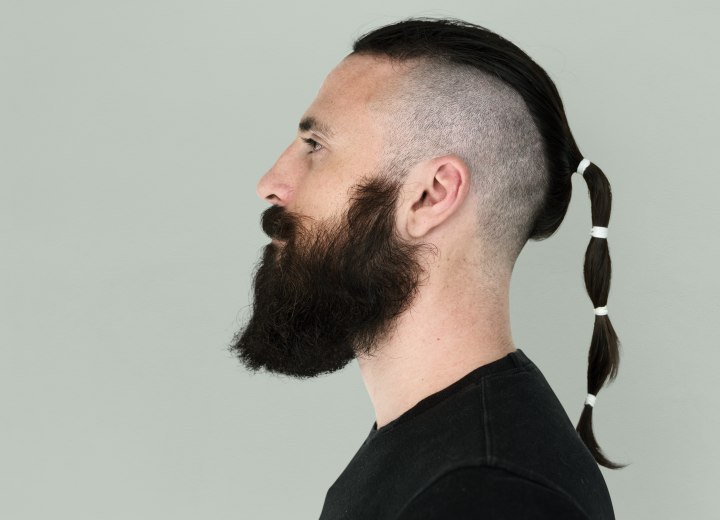Rat Tail Hairstyle

A: This look is known commonly as a Rat Tail hairstyle, and is related to the Mullet, being popular with similar demographic groups during the heyday of both hairstyles. This heyday was the mid-80s to early 90s.
The style became popular in America in the latter half of the 1980s and the earlier half of the 1990s as an alternative to the full-blown “business-in-the-front-party-in-the-back” mullet style. It was considered to be a more “extreme” look and became more prevalent as the traditional mullet grew more mainstream, worn more by those who wanted to remain “different”. Because of this (and the style’s popularity among many “Punks” and “Skinheads”) the style carried a minor reputation of “rebel” in some areas.
The classification of the origin for the style is muddled. As mentioned, the look is seen in ancient works of art from Asia and the East, but has also been popular among a wide range of ethnic groups. There was a brief period after the release of Eddie Murphy’s “Coming to America” wherein his character, Prince Akeem, sports a long rat-tail as a sign of his privilege and station, where rat tails suddenly appeared on the heads of many young African-American men. The sudden development of the rat-tail haircut (specifically in the apparent rapid growth of the tails) in this group was accomplished by the use of extension hair added to the braids to create a long tail braid.
What we can say for sure is that while the purpose for this hairstyle in the ancient past – representing status, social standing, or religious affiliation – the look in later years was intended primarily as a means to assert individuality or a desire to be perceived as a non-conformist or non-traditionalist. Today the style can be readily seen in many Japanese comics (called Manga) where it is common for the characters to have very bold and unusual hairstyles.
However, knowing all of this, the specific reasons for any given individual having and wearing the rat-tail hairstyle will likely be dependent largely upon his (or her) particular demographic group. He may be a young Manga-enthusiast. She may favor an alternative lifestyle and keep her rat-tail dyed a vibrant pink. He may be an aging rocker-wannabe, who just can’t let go of the last vestiges of his hard-living youth. Or, he may be simply a Star Wars enthusiast who fancies himself as a young Padawan (the rat-tail style was used in the recent films to signify a apprentice Jedi’s status and the tail was cut off with his lightsaber when he achieves his full rank as a Jedi Knight)
©Hairfinder.com
See also: Men's hairstyles